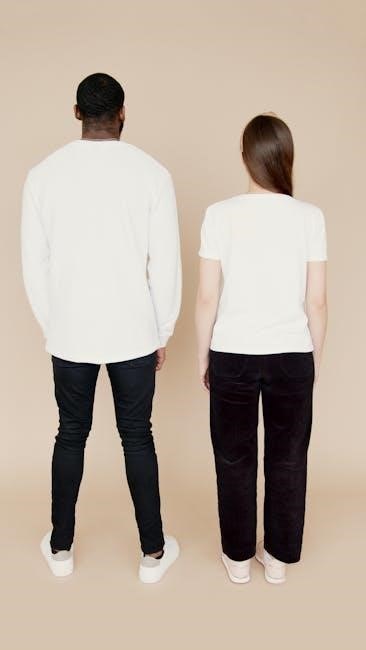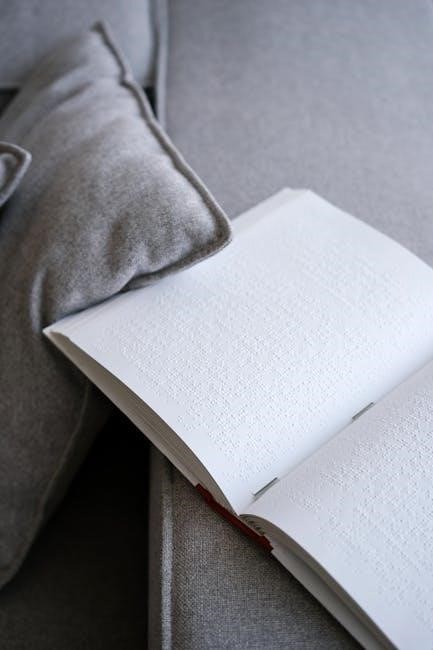Understanding men’s shirt sizing is crucial for a comfortable and flattering fit. This guide helps navigate the world of shirt sizes, ensuring the perfect fit for every body type.

Key Measurements for Shirt Sizing
Accurate measurements are essential for proper shirt sizing. Key measurements include neck, chest, and sleeve length, ensuring a tailored fit for dress shirts, casual tees, and more.
Neck Measurement
The neck measurement is a critical factor in determining men’s shirt sizes, particularly for dress shirts; To measure accurately, wrap a flexible tape measure around the base of your neck, leaving enough space for one finger. This ensures the collar won’t be too tight or restrictive. The measurement corresponds directly to the shirt’s collar size, which varies slightly between brands. For casual shirts like T-shirts, the neck measurement is less precise but still important for comfort and style. Always refer to the brand’s size chart, as some may have slight variations. Proper neck measurement ensures the shirt sits comfortably, avoiding a too-tight or overly loose fit. Whether you prefer a tailored or classic fit, accurate neck measurement is essential for a polished, comfortable look. This step is foundational for choosing the right size, ensuring both style and functionality.
Chest Measurement
The chest measurement is a key factor in determining men’s shirt sizes, as it ensures the garment fits comfortably around the torso. To measure your chest accurately, wrap a flexible tape measure around the widest part of your chest, keeping the tape horizontal and parallel to the ground. This measurement typically corresponds to the shirt’s size label, whether it’s a numerical or alphabetical size (e.g., S, M, L). For dress shirts, the chest measurement is often used in conjunction with the neck measurement to determine the best fit. Casual shirts, like T-shirts, also rely on chest measurements to ensure a flattering silhouette. Remember, sizing can vary slightly between brands, so always refer to the specific size chart provided. Proper chest measurement ensures the shirt isn’t too tight or overly loose, striking the perfect balance between comfort and style. This step is vital for achieving a well-fitted shirt that complements your body type.
Sleeve Length Measurement
Sleeve length is a critical measurement for ensuring a well-fitted shirt, as it impacts both comfort and appearance. To measure sleeve length accurately, start by standing upright with your arms relaxed at your sides. Place the tape measure at the center back of your neck, just below the base of the skull, and extend it down over your shoulder, following the natural curve of your arm to your wrist. The measurement should end at the point where your wrist meets your hand. For dress shirts, sleeve length is often categorized as short, regular, or long, corresponding to different body types and preferences. Casual shirts may have slightly shorter sleeves, but the measurement process remains the same. Proper sleeve length ensures the shirt cuffs sit correctly on the wrist, avoiding a look that’s too short or overly long. This attention to detail enhances both style and functionality, making it essential for a polished appearance.

Understanding Shirt Size Charts
A shirt size chart is a reference tool matching body measurements to shirt sizes, ensuring a proper fit. While helpful, sizes can vary between brands;
Variability Among Brands
One of the most challenging aspects of shirt sizing is the inconsistency across brands. While standard measurements exist, brands often interpret them differently. Some may cut shirts slightly larger or smaller based on their target audience or brand ethos. For example, luxury brands might offer a slimmer fit, while casual brands may prioritize comfort with a looser cut. Fabric type and weave can also affect how a shirt drapes, influencing perceived size. Additionally, terms like “slim fit” or “classic fit” vary in meaning from one brand to another; This variability makes it essential to consult the specific size chart provided by each brand rather than relying on general assumptions. To ensure the best fit, compare your measurements to the brand’s chart and consider reviews or sizing tips from other customers who share your body type.
How to Read a Size Chart
Reading a size chart effectively is crucial for selecting the right shirt. Most charts are presented in a table format, listing measurements such as chest size, neck circumference, and sleeve length. Start by identifying your measurements and matching them to the corresponding size. Pay attention to whether the chart uses numerical sizing (e.g., 14, 16) or alphabetical labels (e.g., S, M, L, XL). Some charts may also include multiple measurements per size to account for variations in body types. Always refer to the specific brand’s chart, as sizing can differ. If you’re unsure, consider measuring yourself again or consulting the brand’s fit guide. Look for additional notes, such as whether the measurements are for a relaxed or fitted style. By carefully aligning your measurements with the chart, you can make a more informed decision and improve your chances of a perfect fit.

Types of Men’s Shirts and Their Fits
Men’s shirts come in various fits, including Slim Fit for a tight, modern look, Regular/Classic Fit for a comfortable, timeless style, and Tailored Fit for a balanced, polished appearance.
Casual/Fashion Fit
A Casual/Fashion Fit shirt offers a relaxed yet stylish silhouette, blending comfort with modern aesthetics. Designed for everyday wear, this fit is slightly roomier than slim-fit shirts but not as loose as classic fits. It typically features a slightly longer sleeve and a broader chest area, allowing for ease of movement while maintaining a fashionable appeal. The casual fit is ideal for informal settings, such as weekends or social gatherings, and pairs well with jeans or chinos. It’s a versatile choice for men who prefer a laid-back look without sacrificing style. This fit is particularly flattering for those with broader shoulders or a more athletic build, as it creates a balanced proportion. When styling, consider layering with a jacket or leaving it open for a relaxed vibe. The casual fit is a timeless option that bridges the gap between comfort and contemporary fashion.
Slim Fit
A Slim Fit shirt is designed to create a modern, streamlined appearance, offering a closer fit to the body compared to classic or regular fits. This style is tailored with narrower sleeves, a shorter length, and a slightly tapered torso to eliminate excess fabric. Slim-fit shirts are popular among younger men and those seeking a contemporary look. They are ideal for professional settings or formal events, as they provide a sharp, polished aesthetic. However, they may feel restrictive for men with broader shoulders or athletic builds. To style a slim-fit shirt effectively, pair it with tailored trousers or a slim-fit blazer for a cohesive look. Avoid layering with bulky items, as this can disrupt the streamlined silhouette. Slim-fit shirts are a great choice for those who want to appear fashionable and put-together without sacrificing comfort.
Regular/Classic Fit
A Regular or Classic Fit shirt offers a traditional and comfortable silhouette, designed to accommodate a wide range of body types. This style is slightly roomier than slim-fit shirts, with a relaxed fit through the chest, shoulders, and sleeves. The classic fit is ideal for everyday wear, providing ease of movement while maintaining a professional appearance. It is particularly suited for men with broader builds or those who prefer a more forgiving fit without sacrificing style. The shirt typically features a slightly longer length and a more generous cut, ensuring comfort and versatility. Regular-fit shirts are a timeless choice, pairing effortlessly with jeans, chinos, or formal trousers. They are also a practical option for men who value comfort and durability without compromising on a polished look. This fit is a go-to for business casual settings and everyday versatility.
Tailored Fit
A tailored fit shirt is designed to provide a sleek, modern silhouette while maintaining comfort. It is slightly slimmer than a regular fit but not as tight as a slim fit, offering a balanced cut that contours the body. This style is ideal for men who want a sharp, polished look without feeling restricted. Tailored-fit shirts typically feature darts in the back for a more defined shape and slightly tapered sleeves for a streamlined appearance. They are versatile enough for both formal and semi-formal occasions, making them a great choice for business meetings or special events. The tailored fit is particularly flattering for men with a medium to athletic build, as it accentuates their physique without being overly snug. It strikes the perfect balance between style and comfort, ensuring a professional and put-together look in any setting. This fit is a popular choice for those who prioritize both aesthetics and functionality in their wardrobe.

How to Measure Yourself for a Shirt
Measure your neck, chest, and sleeve length using a flexible tape measure. Stand straight, keep the tape snug but not tight, and ensure accurate readings for the best fit.
Best Practices for Measurement
When measuring yourself for a shirt, ensure accuracy by using a flexible tape measure and standing upright. Wear a thin, fitted shirt to get precise chest and sleeve measurements. Measure your neck at the base where the collar sits, keeping the tape snug but not tight. For the chest, wrap the tape around the fullest part, ensuring it’s parallel to the floor. Sleeve length is measured from the center back of the neck, over the shoulder, and down to the wrist. Always note your measurements in inches or centimeters for easy reference. Consistency is key, so double-check your measurements and consider having someone assist you for accuracy. Use these measurements to compare with size charts for the best fit. Remember, proper measurement is the foundation for selecting a shirt that complements your body type and ensures comfort.

International Size Conversions
International shirt sizes vary significantly across regions. Use conversion charts to align your measurements with US, EU, UK, or Japanese standards. Always refer to official size guides for accuracy.
US vs. EU Sizing
US and EU sizing systems differ significantly, making conversions essential for international shoppers. In the US, shirt sizes are typically labeled with a neck measurement in inches, such as 14, 15, or 16. In contrast, EU sizes are based on chest measurements in centimeters, often ranging from 38 to 50. For example, a US size 14 corresponds roughly to an EU size 38, while a US size 16 aligns with an EU size 40. However, these conversions are approximate and can vary between brands. EU sizes tend to be more precise, as they directly reflect body measurements, whereas US sizes are more standardized but less tailored to individual metrics. Always check the specific brand’s size chart to ensure accuracy, as variations exist even within regional standards.
UK and Japanese Conversions
UK and Japanese sizing systems for men’s shirts differ significantly, requiring careful conversion for accurate fits. UK sizes are generally based on chest measurements in inches, similar to US sizing, while Japanese sizes often use a numerical system that correlates to chest measurements in centimeters. For example, a UK size 15 (chest 38″) might correspond to a Japanese size 38 or 39. However, these conversions are not always exact, as Japanese sizes can run smaller than UK sizes. To avoid discrepancies, it’s crucial to compare measurements rather than relying solely on numerical sizes. Additionally, Japanese sizing tends to cater to slimmer fits, which may affect the overall fit. Always refer to the brand’s specific size chart for precise conversions, as variations can occur between brands and regions. This ensures the best fit when shopping across international markets.

Common Fit Issues and Solutions
Common fit issues include tight collars, loose chests, or incorrect sleeve lengths. Solutions involve adjusting measurements, choosing tailored fits, or consulting size charts for precise sizing.
- Tight collar: Opt for a slightly larger neck measurement.
- Loose chest: Select a slimmer fit or adjust sleeve length.
Tight Collar
A tight collar can cause discomfort and restrict movement. This issue often arises when the neck measurement is slightly smaller than the shirt’s collar size. To resolve this, consider the following:
- Opt for a shirt with a slightly larger neck measurement or a half-size larger collar.
- Check if the brand offers adjustable cuffs or a relaxed collar style for added comfort.
- Ensure proper posture during measurement to avoid inaccuracies.
Addressing a tight collar ensures a more comfortable and flattering fit, enhancing overall satisfaction with the shirt.
Loose Chest
A loose chest in a shirt can create an unflattering, boxy appearance. This issue typically occurs when the chest measurement is smaller than the shirt’s chest dimension. To address this:
- Consider sizing down to achieve a more fitted silhouette.
- Look for shirts labeled as “slim fit” or “tailored fit,” which are designed to skim the body.
- Pay attention to fabric thickness, as heavier fabrics may provide better structure and reduce looseness.
- Ensure proper posture during measurement to get an accurate chest size.
Addressing a loose chest ensures a more streamlined and polished look, enhancing both comfort and style.
Sleeve Length Issues
Sleeve length issues are common and can significantly impact the overall fit of a shirt. Sleeves that are too short may expose the wrists, while sleeves that are too long can create a bulky appearance. To resolve this:
- Ensure accurate sleeve length measurement from the center back of the neck to the wrist with a slightly bent elbow.
- If sleeves are too short, consider sizing up or opting for a shirt with adjustable cuffs.
- For sleeves that are too long, tailoring is a practical solution to achieve the perfect fit.
- Pay attention to shirt styles, as some are designed with longer or shorter sleeves based on the intended fit.
Addressing sleeve length issues ensures comfort and a polished look, making it easier to pair shirts with jackets or wear them on their own.

How to Use a Size Chart Effectively
Using a size chart effectively ensures the best fit. Begin by accurately measuring your neck, chest, and sleeve length. Match these measurements to the chart, aligning them with the provided sizes. Consider the shirt’s intended fit—slim, regular, or classic—to suit your body type and preference. Double-check your measurements to avoid discrepancies, as even slight differences can impact comfort and appearance. Be mindful of fabric type and brand-specific sizing, which can influence fit; Avoid common mistakes like guessing your size or overlooking fit guidelines. By following these steps, you can effectively use a size chart and enjoy a well-fitting shirt tailored to your needs.
- Measure accurately before referencing the chart.
- Select a size that matches your measurements and desired fit.
- Account for brand variations and fabric types.
- Double-check measurements for consistency.
- Use the chart as a guide; avoid guessing sizes.

The Role of Fabric in Shirt Fit
Fabric plays a crucial role in how a shirt fits and feels. Different materials drape differently on the body, influencing comfort and appearance. Cotton, for instance, is breathable and soft, offering a natural fit, while polyester blends may provide durability but can sometimes feel stiffer. Linen fabrics are lightweight and loose-fitting, ideal for casual styles, but may lack structure. The elasticity of the fabric also matters; stretch blends like spandex-enhanced cotton offer a more tailored fit, while non-stretch fabrics rely on precise measurements for comfort. Additionally, fabric weight impacts the fit—thicker fabrics may add bulk, whereas lighter ones skim the body. Consider the fabric’s texture and weave when choosing a shirt, as these factors can enhance or detract from the overall fit. Always align fabric choice with the intended use and desired style to ensure the best fit.
- Cotton: breathable, soft, natural drape.
- Polyester blends: durable but less flexible.
- Linen: lightweight, casual, loose-fitting.
- Stretch fabrics: tailored, form-fitting.
- Fabric weight: heavier fabrics add bulk, lighter ones skim the body.

FAQs About Men’s Shirt Sizing
- What if I’m between sizes? Opt for the larger size for comfort.
- How do I choose the right fit for my body type? Slim fits suit lean builds, while classic fits accommodate broader frames.
What If I’m Between Sizes?
If you find yourself between sizes, it’s important to consider the shirt’s intended use and your personal comfort preferences. For casual shirts, sizing up ensures ease of movement and a relaxed fit. For dress shirts or slim-fit styles, consider the smaller size if you prefer a tailored look, but ensure it doesn’t feel restrictive. Measure yourself again to confirm accuracy, as body measurements can fluctuate. If unsure, try the shirt on if possible, or check the retailer’s return policy for online purchases. Ultimately, prioritize comfort and confidence in your choice; Many brands also offer alternative sizing options or adjustable features, such as stretch fabrics, to accommodate varying body types. Don’t hesitate to reach out to customer service for guidance if needed. Remember, the right fit enhances both appearance and wearability.
How Do I Choose the Right Fit for My Body Type?
Choosing the right fit for your body type ensures comfort and a flattering appearance. For slim builds, slim-fit or tailored shirts accentuate a lean physique without appearing too tight. Muscular individuals may prefer a tailored or classic fit to accommodate broader shoulders and chests while maintaining a streamlined look. Those with an average body type can opt for slim-fit or regular-fit shirts depending on personal preference. If you have a larger frame, a classic or relaxed fit provides comfort and ease of movement. Tall men should look for shirts with longer sleeves and torsos to proportionally fit their height. Consider your lifestyle and the occasion—casual shirts offer versatility, while dress shirts are better for formal events. Always refer to size charts and measure yourself to ensure the best fit. Prioritizing both style and comfort will help you make the most appropriate choice for your body type and needs.
Understanding men’s shirt sizing is essential for ensuring a comfortable and stylish fit. By focusing on key measurements like neck, chest, and sleeve length, you can navigate size charts with confidence. Remember, fit preferences vary, and choosing between slim, regular, or tailored styles depends on your body type and lifestyle. International size differences and fabric types also play a role in achieving the perfect fit. If you’re between sizes or unsure, consider the fit issues addressed earlier, such as tight collars or sleeve length discrepancies, and explore solutions like tailoring or size adjustments. Ultimately, taking accurate measurements and using size charts effectively will guide you to the ideal shirt for your needs. With these insights, you’ll be well-equipped to select shirts that enhance your appearance and provide lasting comfort.



